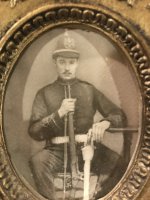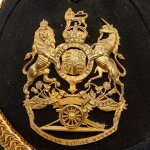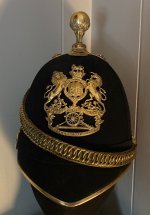You are using an out of date browser. It may not display this or other websites correctly.
You should upgrade or use an alternative browser.
You should upgrade or use an alternative browser.
Can anyone identify the helmet in the photo?
- Thread starter newbie12
- Start date
Khukri
Well-known member

Original British Victorian Army Artillery Officer Blue Cloth Dress Spike Helmet by Hawkes and Co - Pre-WWI
Original Item: Only One Available. This is a well used but solid condition Victorian era British Army Officer Blue Cloth Spiked helmet which is with its ball finial and without scaled chinstrap. The chin strap lugs and spike base ends are all properly adorned with embossed roses. This helmet has...
Khukri
Well-known member
ArtilleryView attachment 59370Allegedly a British soldier circa 1830-1880s. Perhaps someone can identify via the helmet, uniform or weapon. Thank you in advance.
Attachments
Khukri
Well-known member
Very nice helmet!Yes most likely British or Canadian Artillery. Hard to be 100 percent sure with the blurry photo.
Here is my British one.
Peter B
Well-known member
One thing I did just notice is that it looks like a spike and not a ball on top so may not be artillery. Our resident British Helmut collector may chime in as he has quite a few helmets like this and might have a better idea of the badge. No way to get a clearer picture?
seagull
Well-known member
A clearer picture would be good but meanwhile,... the helmet could be gilt fittings for regular army or silver for home service - we can't tell which but the Bluecloth helmet was introduced 1878 with spike top for all branches of service and all ranks until 1881 when the ball top was adopted by the artillery. Personally I think this one looks like a post 1881 ball top for artillery as the spike is much more slender than we see here, plus, he is holding a Snyder breech loading Carbine - used by artillery and transport troops. Incidentally the picture is printed in reverse - note the lock on the 'wrong' side of the stock!
Peter B
Well-known member
Yes it definitely could. I still think now it looks like a spike and not a ball top but again without a clearer picture hard to say.It could be a soldier of the british engineers.
iStock
iStock. Die offizielle iStock-Website bietet Millionen exklusive, lizenzfreie Dateien. Um die perfekte Foto, Video oder Vektor finden, nach unserer Sammlung jetzt.www.istockphoto.com
Yeohelmetguy
Well-known member
Hello newbie12,View attachment 59370Allegedly a British soldier circa 1830-1880s. Perhaps someone can identify via the helmet, uniform or weapon. Thank you in advance.
I would like to provide you with some information regarding the question you asked concerning the picture you posted here. As several other members of the Forum have already correctly identified, your image as a British Army Royal Artillery gunner circa 1878. Since the home service helmet was introduced in 1878 and he is still armed with a Snider-Enfield muzzle loaded rifle converted to breech loading, the more modern Martini-Henry breech loading rifle introduced to the regular army first in 1871, he most likely is a member of one of the many volunteer Royal Artillery batteries or brigades that were organized across the United Kingdom. He would be further identified or distinguished as an artillery man by the helmet plate to the front of his helmet and the ball tipped spike to the top of his helmet and as a volunteer, these fitting would be executed in white metal, regular and militia Royal Artillery formations would have these fitting in brass metal for other-ranks and gilt medal for officers. The ball top to the helmet was not confined to the Royal Artillery; other corps’ such as the Royal Medical Corps, the Army Veterinary Corps/Department, the Ordinance Corps, the Commissariat and Transport Corps and other corps’ that were horse mounted used the ball top… the rational was the ball would be safer to wear around horses than the pointed spike worn by the infantry. Even officers of infantry when mounted would replace their pointed spike with the ball spike. By regulation the pointed spike was to be worn by the Royal Artillery with the regulations being amended in 1881 to use the ball, the ball was in fact taken into use by the Royal Artillery from the introduction of the blue cork home service helmet in 1878. Additionally, the ball spike was longer/taller on officer's helmets compared with those on other-ranks helmets.
I have included serval pictures of Royal Artillery helmets and helmet plates in my collection. They are a Victorian officer’s home service helmet to the ABERDEEN CITY ARTILLERY VOLUNTEERS with silver fittings in the original 1878 pattern as introduced with a rounded front peak. This front peak pattern lasted about one year before the more familiar pointed front peak pattern came into use. The second helmet is a Victorian officer’s home service helmet to a REGUALR ROYAL ARTILLERY officer with gilt fittings and the pointed front peak. The last helmet is an Edwardian issued other-ranks helmet dated 1912 with brass fittings. The redesign of the front peak did not apply to other-ranks helmets as demonstrated with this third helmet. I have also included a couple of miscellaneous ROYAL ARTILLERY helmet plates from my collection too: a ROYAL ARTILLRY MILITIA officers helmet plate in gilt medal and another volunteer helmet plate to the 1st MIDLOTHIAN COAST ARTILLRTY VOLUNTEERS. I hope this thumbnail sketch is helpful and of interest to you.
Cheers,
David
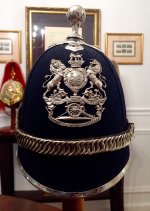
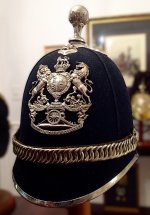
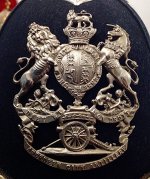
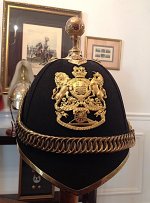
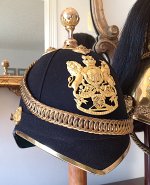
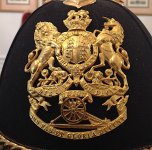

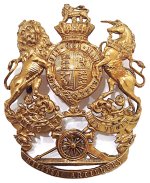

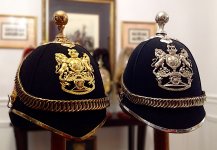
Last edited:
Yeohelmetguy
Well-known member
It could be a soldier of the british engineers.
iStock
iStock. Die offizielle iStock-Website bietet Millionen exklusive, lizenzfreie Dateien. Um die perfekte Foto, Video oder Vektor finden, nach unserer Sammlung jetzt.www.istockphoto.com
Hi Sandy... an Edwardian (the Victorian version would be similar with Queen Victoria's crown in place of the Tudor or King's crown as in this example) British Army Royal Engineers helmet plate below... notice there is no title scroll at the bottom of the helmet plate and in newbie12's picture the bottom arc is the regimental title scroll and despite his picture being a bit blurry, the field gun is easily made out between the Royal Arms and that bottom title scroll/arc...
Cheers,
David
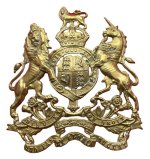
Peter_Suciu
Well-known member
Agreed, the soldier in the period photo is a Royal Artillery trooper. It appears to be an OR helmet.Hi Sandy... an Edwardian (the Victorian version would be similar with Queen Victoria's crown in place of the Tudor or King's crown as in this example) British Army Royal Engineers helmet plate below... notice there is no title scroll at the bottom of the helmet plate and in newbie12's picture the bottom arc is the regimental title scroll and despite his picture being a bit blurry, the field gun is easily made out between the Royal Arms and that bottom title scroll/arc...
Cheers,
David
Peter_Suciu
Well-known member
I am no expert (on anything) but I know I know far more about British home service helmets than Pickelhaubes, even after all the years on this forum!Hello and welcome.
Only a few members are specialized in British spike helmets, here.
We generaly discusse German spike helmets.
It could take some time before you get the right answer....
Sandmann
Well-known member
Very interesting information. Thank you very muchHello newbie12,
I would like to provide you with some information regarding the question you asked concerning the picture you posted here. As several other members of the Forum have already correctly identified, your image as a British Army Royal Artillery gunner circa 1878. Since the home service helmet was introduced in 1878 and he is still armed with a Snider-Enfield muzzle loaded rifle, the more modern Martini-Henry breech loading rifle introduced to the regular army first in 1871, he most likely is a member of one of the many volunteer Royal Artillery batteries or brigades that were organized across the United Kingdom. He would be further identified or distinguished as an artillery man by the helmet plate to the front of his helmet and the ball tipped spike to the top of his helmet and as a volunteer, these fitting would be executed in white metal, regular and militia Royal Artillery formations would have these fitting in brass metal for other-ranks and gilt medal for officers. The ball top to the helmet was not confined to the Royal Artillery; other corps’ such as the Royal Medical Corps, the Army Veterinary Corps/Department, the Ordinance Corps, the Commissariat and Transport Corps and other corps’ that were horse mounted used the ball top… the rational was the ball would be safer to wear around horses than the pointed spike worn by the infantry. Even officers of infantry when mounted would replace their pointed spike with the ball spike. By regulation the pointed spike was to be worn by the Royal Artillery with the regulations being amended in 1881 to use the ball, the ball was in fact taken into use by the Royal Artillery from the introduction of the blue cork home service helmet in 1878. Additionally, the ball spike was longer/taller on officer's helmets compared with those on other-ranks helmets.
I have included serval pictures of Royal Artillery helmets and helmet plates in my collection. They are a Victorian officer’s home service helmet to the ABERDEEN CITY ARTILLERY VOLUNTEERS with silver fittings in the original 1878 pattern as introduced with a rounded front peak. This front peak pattern lasted about one year before the more familiar pointed front peak pattern came into use. The second helmet is a Victorian officer’s home service helmet to a REGUALR ROYAL ARTILLERY officer with gilt fittings and the pointed front peak. The last helmet is an Edwardian issued other-ranks helmet dated 1912 with brass fittings. The redesign of the front peak did not apply to other-ranks helmets as demonstrated with this third helmet. I have also included a couple of miscellaneous ROYAL ARTILLERY helmet plates from my collection too: a ROYAL ARTILLRY MILITIA officers helmet plate in gilt medal and another volunteer helmet plate to the 1st MIDLOTHIAN COAST ARTILLRTY VOLUNTEERS. I hope this thumbnail sketch is helpful and of interest to you.
Cheers,
David
View attachment 59425
View attachment 59426
View attachment 59427
View attachment 59428
View attachment 59429
View attachment 59430
View attachment 59431
View attachment 59432
View attachment 59437
View attachment 59434

